| کد مقاله | کد نشریه | سال انتشار | مقاله انگلیسی | نسخه تمام متن |
|---|---|---|---|---|
| 2417333 | 1104316 | 2009 | 5 صفحه PDF | دانلود رایگان |

Many aquatic invertebrates alter their behaviour in response to chemical stimuli from predators. Less is known about how finely prey can discriminate between stimuli from predatory and related nonpredatory species, even in well-studied hermit crabs. We tested the time to emerge from the shell after disturbance (hiding time) of a common intertidal hermit crab. Pagurus granosimanus was exposed to effluent from two large-bodied brachyuran crabs: the durophagous, predatory red rock crab, Cancer productus, and the herbivorous kelp crab, Pugettia producta, in a controlled laboratory setting. Hiding times were a dramatic 41% shorter in the presence of Cancer effluent than when exposed to Pugettia effluent, which did not differ from a sea water control. Therefore hermit crabs can distinguish between chemical effluent from predatory and nonpredatory brachyuran crabs, which could include crab-specific compounds or metabolites from recently consumed prey, and adjust their behaviour accordingly. Shorter hiding times probably decrease the risk of being eaten by a shell-breaking predator because hermit crabs may be better able to elude them, either by running rapidly away or by abandoning their shell before it is crushed. Individual tests with three video stimuli (control, predatory crab, herbivorous crab), and combined tests with video and chemical stimuli, revealed a consistent generalized response to the presence of video but no differences among video treatments.
Journal: Animal Behaviour - Volume 78, Issue 3, September 2009, Pages 691–695